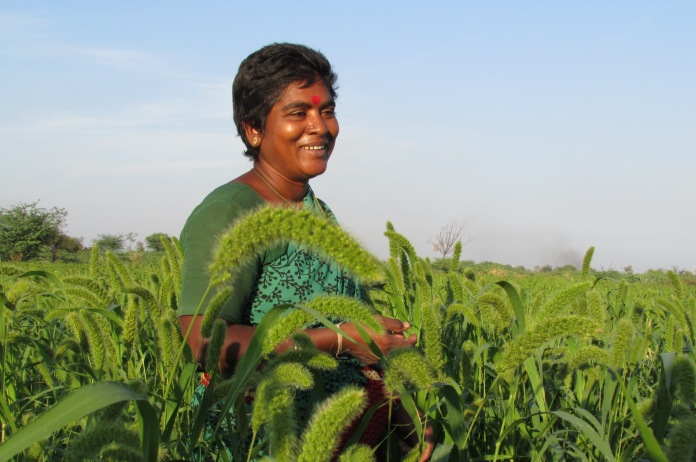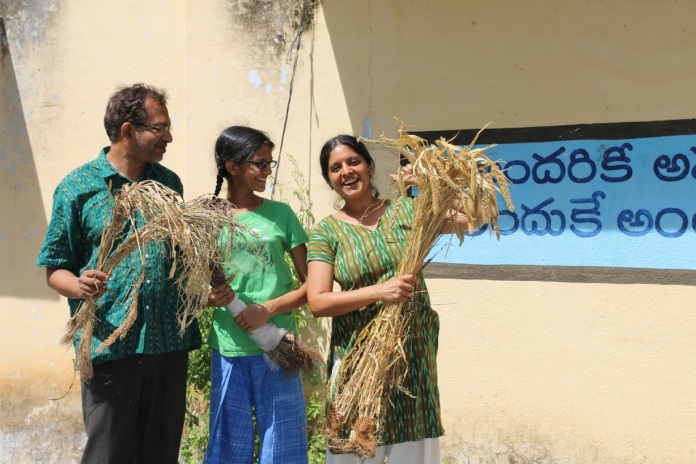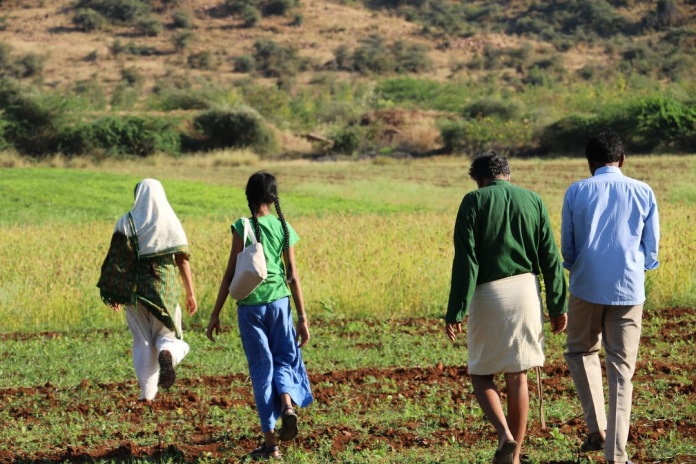We left Potnal yesterday morning, visited an NGO en route and reached Kadiri at 8 pm. Dinesh met us near the bus stop on his motorcycle and we followed him to his home, with a brief stop at Earth 360, the millet processing factory that he set up, which we were pleased to hear, was doing well. Involved in every step of promoting millets, linking farmers and consumers, the company had grown and was breaking even while upholding the values with which it began 5 years ago, holistic health for people and planet through sustainable agriculture rooted in diverse, local, whole grains (also called coarse grains). In brief: millets for all, health for all.
A sign painted on the factory wall reads:
అందరికి అవసరం ఆరోగ్యం
అందుకే అందిదాం చిరుధాన్యం
or “Everyone needs health. So let’s see that everyone gets coarse grains.”
Among the many ways they stay true to their values in spite of market pressures, they sell only unpolished grains. These days one finds many companies selling polished millets, which appear white in color. So if the little millet, kodo millet et al that you find in your local market is white, you may want to suggest they procure from Earth 360 and make sure to get the whole grain.
This morning we took a proper tour of the plant and met some of the workers. They told us that at Earth 360 they were encouraged to work in every department and learn the whole business from contacting farmers to supply the raw grains to processing and packing to contacting wholesale and retail buyers.
In fact, this company goes a step further and helps farmers who want to move into organic farming and millet cultivation get access to training, government schemes and subsidies. A few of the young men said they would be ready to start their own such unit. The women were not so sure, but some were also thinking in that direction and working on getting there. Dinesh, for his part, felt all of them needed more experience and sense of responsibility for each step, ensuring quality of the final product and timely fulfillment of orders. When they gain that level of experience and expertise, he hopes that they can start a similar unit in another village and eventually cover all of Anantapur District, which is a drought-prone area and suitable for millet cultivation.
After lunch, we visited some millet farmers in some villages in Kadapa District, near Pulivendula, about an hour’s drive from Kadiri. One farmer, Vijay Kumar in T. Yelamavaripalli runs a phone helpline for farmers. He teaches them organic farming techniques such as intercropping, vermiculture, and how to make organic fertilizers and pest repellents. He had gotten a call that day from a woman named Nagalakshmi, who spotted a worm on her foxtail millet crop. He was puzzled as he had not seen such a thing before. We went with him to her farm in Mittapalli, near Yerra Guntla to look into it.

Nagalakshmi has sown kodo and foxtail millet on her small farm in Mittapalli in Kadapa District, Andhra Pradesh.
After inspecting the worm, Vijaykumar assured Nagalakshmi that it would not disturb her crop. I asked him why. He pointed out that the husk of foxtail millet was too coarse for this particular worm to eat through. He added that the crop would be ready for harvest before the worm could reproduce. The worm would not have come for the foxtail millet, he surmised. There was another crop nearby attracting this particular worm, and a few had strayed into the millet field.
We talked with Nagalakshmi to find out how long she had been cultivating millet and what prompted her to try it. She said that it was much easier to use vermicompost and other natural inputs rather than costly fertilizers and the crops were growing well even when rains were low. She said that she had gotten timely support and would like to encourage other farmers to grow millet as well. .
She wanted to put in a drip irrigation system in her farm, and tried to avail a government subsidy that would enable her to get it for Rs. 10,000 rather than Rs 100,000. But she is unable to afford even Rs. 10,000 upfront. If she doesn’t get the system by March she may lose the crop. We helped organize a loan for that amount.
Farmers like Nagalakshmi and Vijay Kumar and resources persons like Dinesh are making it possible for people far away from the farms to eat traditional grains, to diversify our diets, and to support economically viable and ecologically sustainable agriculture that will restore the health of the soil and the society. At the Vennela Rural Development Society office in Vempalle, we talked with them late into the evening about their further plans to offer support to farmers interested in cultivating millets, to train more trainers and reach more farmers. Earth 360 has so far been able to absorb the supply and is a model of a socially conscious enterprise, that others with a passion for millet and a mind for business could replicate.
We carried samples of all their products to help spread the word wherever we went.

Outside the Earth 360 factory. The sign behind us reads అందరికి అవసరం ఆరోగ్యం
అందుకే అందిదాం చిరుధాన్యం or “Everyone needs health. So let’s see that coarse grains are available for all.”






Really happy to see millet cultivation